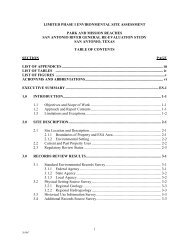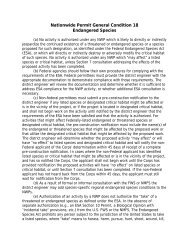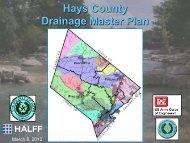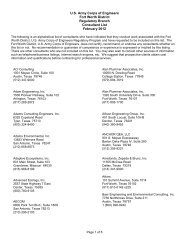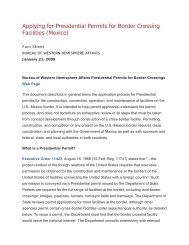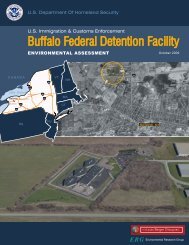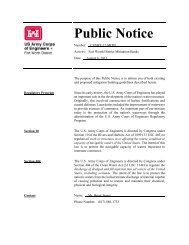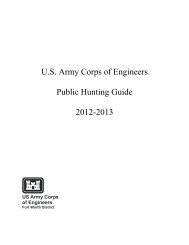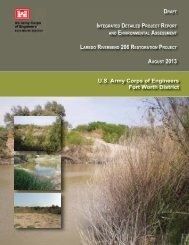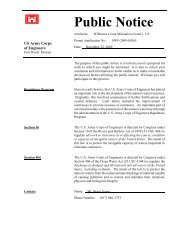environmental assessment us border patrol, tucson sector
environmental assessment us border patrol, tucson sector
environmental assessment us border patrol, tucson sector
You also want an ePaper? Increase the reach of your titles
YUMPU automatically turns print PDFs into web optimized ePapers that Google loves.
3-3112345678910111213141516171819202122232425262728293031323334353637383940414243444546After A.D. 1300, cultural material in much of the San Pedro River Valley is characteristic of thelate Classic Salado culture. Within the lower San Pedro River Valley this presence is indicatedby a wealth of Gila Polychrome pottery, as well as multi-roomed, masonry structures surroundedby a compound wall. Some archaeologists believe that compound walls were built to provideprotection from hostile invaders (Rice 2001; Wallace and Doelle 2001). Others suggest thatcompound walls were built to protect and hide ho<strong>us</strong>ehold possessions during economically hardtimes (Fish 1999).Protohistoric PeriodThe Protohistoric period covers the time period following the collapse of the Classic periodsystems, but preceding contact with Europeans. Reasons for the dramatic changes to indigeno<strong>us</strong>populations at the end of the Classic Period are not well understood. However, similar shifts insettlement systems and social complexity occur across the southwest during the A.D. 1400s. Inthe San Pedro River Valley, the Piman-speaking Sobaipuri resided in villages of 20 to severalhundred ho<strong>us</strong>es (Ferg<strong>us</strong>on et al. 2004). Domestic architecture was characterized by domeshaped,oval, bent-pole structures. Sobaipuri pottery, known as Whetsone plainware, wastypically unpainted and unpolished, but quite thin and hard. Distinctive Sobaipuri-styleprojectile points have also been documented. Ethnohistoric records indicate that the Sobaipuriwere often engaged in conflict with neighboring groups of Apaches, though there are someindications that this conflict escalated sharply following the arrival of the Spanish in the lateseventeenth century (Seymour 1993).The Athabascan hunter-gatherer bands, eventually called the Southern Chiricahua Apache (alsoidentified as the Gila Apache), first appeared after AD 1450 and probably prior to the arrival ofthe Spanish. Their removal from the area by the U.S. Army was completed during the 1880s.The Southern Chiricahua were highly mobile hunter-gatherers moving through differentecological zones of established territories on an annual round. Group size varied depending onthe season and project. Large-game animals exploited by the Southern Chiricahua included muleand white-tail deer, pronghorn antelope, and elk. It is assumed that smaller game animals werealso hunted, such as rabbits and rodents. Plant resources utilized included agave, acorns,mesquite beans, pinon nuts, datil yucca fruit, and prickly pear tunas. It is unclear whether theseApache adopted horticulture, but other Apachean groups did grow corn, and possibly cultivatedtobacco. In addition to hunting and gathering wild resources, the Apache supplemented theirdiets with foods obtained from Spanish and later Mexican settlements through trading or raiding.When the Spanish entered the region in 1581, they bypassed the hunter-gatherers theyencountered beca<strong>us</strong>e their lifeways made the potential for colonization, conversion, andappropriation of agricultural supplies much lower than the sedentary Pueblos. Overall, theSpanish-Mexican presence in southeast Arizona was light, reflecting the failure of militaryefforts to contain and subdue the Apache raiders.Historic PeriodFollowing decades of conflict with Apaches and other groups, the Sobaipuri abandoned the SanPedro River Valley in 1762 and moved to the Tucson area, joining other Piman-speaking groupsat San Xavier del Bac, San Aug<strong>us</strong>tín del Tucson, and other villages along the upper Santa CruzRiver. Apaches continued to <strong>us</strong>e the San Pedro River Valley until the late nineteenth century,Douglas FOB EADraftAug<strong>us</strong>t 2011



